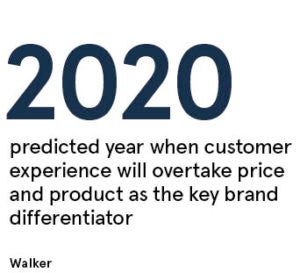Customer experience is the current battleground. Companies are looking to gain a competitive advantage by transforming their customer experience.
Global marketing and technology agency, Digitas is one company encouraging and guiding businesses – from bluechip multinationals to startups – through this transformation: A transformation that urges businesses to do-away with disjointed silo approaches to technology, marketing and communications, and instead bring them together.
“Our capabilities as an agency revolve around integrating media, technology, customer relationship management and communications within the same offering,” says the company’s UK chief executive Dani Bassil. “It’s about combining marketing and technology in new ways, getting traditionally disparate functions to work in tandem so your marketing activity synchronises perfectly with your digital platforms, apps and websites.”
This new era of customer experience is best described as a total brand experience, creating a connected and differentiated experience platform that spans both brand communications and digital touchpoints.
“It’s a new concept which requires imagination and the ability to reframe opportunities in new and interesting ways,” says Ms Bassil. “But if companies get it right, they will be able to harness the power of creativity and the power of technology to find new opportunities for growth.”
This total brand experience recognises the importance of brand and the importance of customer experience. In some cases, an ad’s creativity builds memorability leading people to buy a product. In others, it’s not the ad that makes the difference, it’s the digital experience.
“These two schools of thought sometimes oppose each other as one is geared at utility and ease, while the other focuses on brand differentiation,” Ms Bassil explains. “It doesn’t mean you can’t bring them together, though. In fact, do so and you can achieve memorable and frictionless experiences simultaneously.”
 It is not only better for the customer, but better for the business too, reducing the cost to serve customers or increasing acquisition, while also improving brand health; not the usual success measure associated with customer experience.
It is not only better for the customer, but better for the business too, reducing the cost to serve customers or increasing acquisition, while also improving brand health; not the usual success measure associated with customer experience.
For example, Digitas was tasked with selling holidays on the website of a well-known transatlantic airline. When testing the experience they found that the speed of the search interaction was leading users to believe that the recommendations weren’t well-considered or tailored to them. So they slowed the page down, added in a ‘spinner’ and some brand copy. By using counterintuitive, creative thinking not only did online conversion increase but so did brand favourability.
So how do companies position themselves to take advantage of the next evolution in customer experience? Inevitably, there isn’t a magic tool to bridge the traditional, silo approach. It requires cultural, organisational transformation to instil such fluency between marketing and technology, and create a connected experience where the silos are not noticeable to the end-customer.
“People don’t care that one brand interaction is served by the technology silo and another by the marketing silo, and nor should they,” says Ms Bassil. “They don’t want or need to see the transformation journey that the business is on. To them, the brand, product and experience are indistinguishable from each other.”
This presents challenges to the traditional corporate structure, from changing how key C-level positions should be organised and integrated, designing talent strategies that focus on developing people who are “bilingual” in marketing and technology, and embedding data and technology to ensure a connected experience.
“It has to be an organisation-wide initiative and that’s why the creation of a total brand experience is difficult to implement,” Ms Bassil concludes. “It’s also why, if you can get it right, it presents a real opportunity to differentiate your business against competitors.
“We believe the successful blending of marketing and technology will enable companies to gain a significant competitive advantage in the years to come.”
For more information please visit digitas.com




